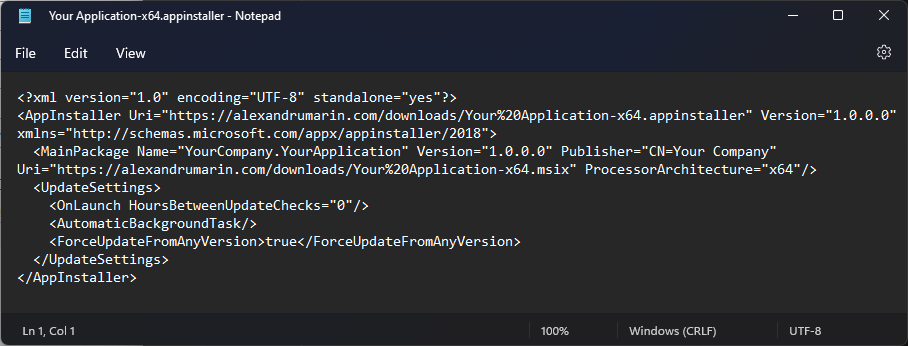What is App Installer? And how to use it to simplify MSIX installation and updating process
In our previous articles, we discussed How to Set Automatic MSIX Downgrades with .appinstaller and the MS-AppInstaller Web Protocol, and now we will be discussing the technicalities of the .appinstaller.
Let’s dive deeper into what the .appinstaller file is and how it works, offering a comprehensive overview of its design and demonstrating the steps for creating one using Advanced Installer.
What is Windows App Installer?
The .appinstaller file was introduced with Windows 10 version 1709 to make application distribution easier. From that point, users were able to use the .appinstaller file to handle all the necessary configurations instead of installing the actual app container.
At its core, the app installer file is an XML file that can be easily created either:
- manually, using Visual Studio or
- automatically with the help of a packaging tool, such as Advanced Installer tool.
If you have an .appinstaller file created, when an update is available for your application, you will only need to update the .appinstaller file. Then, the new app container gets pushed to your users, providing a faster update process for both you and your users.
When using the .appinstaller file, you can also declare dependencies that are placed on different shares or even in the Microsoft Store. If an application is declared mandatory, the .appinstaller file will first download it and install it according to the order you declared.
First time working with dependencies? Check out our article: MSIX Applications: Handle Prerequisites by Declaring Dependencies in MSIX, and gain the knowledge you need to handle dependencies in MSIX.
How does App Installer distribution work?
A key advantage of the .appinstaller file is its small size, typically only a few KB, making it convenient to store in any location desired. Also, Microsoft added the MS-AppInstaller Web Protocol which lets you easily create a launch link on your website.

What are the App Installer Contents?
The .appinstaller file, as we mentioned before, is a simple XML file. So, if you are building it manually, you need to follow the schema defined by Microsoft. Also, you can configure the behavior of the app updates according to your needs.
For example, in the image below, you can see that in the UpdateSettings element, the OnLaunch and HoursBetweenUpdateChecks are set to 0.
The AppInstaller will automatically check for updates each time the application is opened. If a newer version of the .appinstaller file is available at the specified URI, the AppInstaller will read it and initiate the update process.

In essence, when configuring an .appinstaller file, you are:
- specifying the location of the .appinstaller file,
- identifying the main and optional packages to be installed,
- setting up any necessary shares, and
- determining the update behavior of the application.
How to create an App Installer with Advanced Installer?
Compared to the previous version where you had to create the .appinstaller file manually, Advanced Installer enables you to quickly create it directly from its GUI, automatically.
You check the Advanced Installer App Installer functionality through its 30-day full featured trial.
To create your .appinstaller file in Advanced Installer, follow these steps:
1. Navigate to the Builds page in your project.
2. Select your MSIX build, in this case, Build_MSIX_APPX.
3. Click on the App Installer tab.

4. In the URL section, paste where your .appinstaller and MSIX will be located. In this scenario, we are using a local share (here's where you must specify your own URL).
5. Specify the needed Frequency check. In this case, we went with 0, which means that every time the application is started, it will check on our server to see if an update is available.
6. Check the Force update from any version.
7. Click Build in the upper left corner.
When you navigate to the output folder, you will see the .appinstaller file created, and if we open it up, it looks exactly as the one created manually.

Conclusion
As you can see, the app installer file streamlines the installation and updating processes for the end user, making it a highly convenient solution.
Do you have any other topics you would like us to cover? Let us know in the comments!
